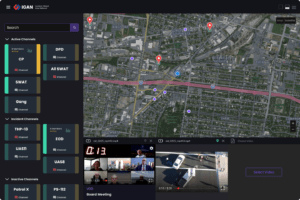 Police in North Texas using drone-based technology to save officers’, civilians’ lives with Drone Clear
Police in North Texas using drone-based technology to save officers’, civilians’ lives with Drone Clear
By Jim Magill
Police in North Texas are using drone-enabled video technology to help them clear buildings of potential threats, reducing the potential of harm coming to either officers or civilians.
The Dallas Police Department Unmanned Aircraft Systems unit was the first to deploy the Drone Clear program, which utilizes technology developed by video and audio software developer Cytta Corp. Under the program, a single UAS or multiple drones can be flown into a building in which there is a perceived threat, such as an armed suspect.
The drones act as sentries, sending video data to multiple actors, including remotely located incident commanders as well as officers on the scene. The data helps responders map out the structure, identifying potential threats before the decision is made to send officers into the building.
“We’re trying to find a way to reduce or eliminate the unplanned use of force,” said Dallas Police Sergeant Ross Stinson, who heads Dallas PD’s UAS squad.
“The UAS goes in first and develops the situational awareness, so that when officers do wind up making entry or moving into a confined space, they have all the information necessary to gain compliance or find other ways to go in rather than having a planned use of force,” Stinson said.
The Drone Clear protocol was developed using Cytta’s propriety Incident Global Area Network (IGAN) technology, which allows real-time video streaming to be shared by multiple parties, who can also use the platform to communicate with one another.
“Cytta specializes in video-compression technology that provides low-bandwidth, mission-critical video streaming,” said Cytta CEO Gary Campbell. The IGAN technology is device-agnostic, which means that police officers don’t need to have special devices, but can get the video feeds and talk to one another using their cell phones.
“It’s taking feeds from both video and radio devices. It aids in virtual policing and it’s really making a difference in multiple types of incident response,” he said.
The Dallas P.D. developed the Drone Clear protocol in partnership with the Special Response Team of the Homeland Security Investigations, the SWAT unit of the federal Department of Homeland Security. Stinson described Drone Clear as “not so much a specific tactic as an approach to utilizing the hardware and the software to achieve that outcome.”
Last month Dallas police used the Drone Clear protocol to help capture a murder suspect, who had hidden inside a house.
“We utilized the technique to put eyes in as much of the house as possible,” Stinson said “We prevented any type of ambush on the officers and we were able to isolate the suspect in the house and make a successful apprehension, knowing we had safe spaces to work.”
Michael Collins, Cytta’s chief technology officer, said the company began combining its technology with drones in 2008, while working with the military to design a system that enabled low-bandwidth two-way video and audio communications.
In its commercial application, IGAN facilitates two-way communications among different public service agencies that are responding to the same event. The system allows multiple users to view video data on their personal devices, rather than “everybody hovering over the pilot looking at his screen to see what’s going on,” he said.
In a typical application of the Drone Clear program, a police agency will deploy multiple small drones, typically DJI Mini 2s, to feed video to the command center and other interested observers through the IGAN platform. Upon encountering a situation such as an armed subject hiding inside a house or other building, police can fly five or six drones into the structure.
The drones can be flown to strategic locations throughout the structure and landed so they can act as static observation posts, keeping an eye on certain spots where an active shooter might be hiding, such as in a closet or under a bed. This technique preserves the drones’ battery life, while allowing officers to gain situational awareness of the potential threats they may have to face before they enter into each room of the building.
“The mission is to take video before they go in and share that with everyone,” Collins said.
IGAN technology uses
In addition to Dallas P.D.’s development of the Drone Clear program, police agencies in North Texas also have deployed drones in conjunction with Cytta’s IGAN technology in a number of different applications.
Lt. Clayton Regan, a patrol commander with the Midlothian Police Department, said that for the past several years Cytta has been working closely with a group of police agencies through the North Texas Public Safety Unmanned Response Team (PSURT) to develop drone-related solutions for a number of public safety situations.
For example, police used the IGAN platform to help control traffic at Denton County’s mass COVID-19 vaccination hub held at the Texas Motor Speedway over five days in February, as well as at Fair Park in Dallas where Dallas County held its mass vaccinations. At the Motor Speedway event, police employing the drone-enable technology were able to keep an orderly flow of traffic as health care workers administered 10,000 shots per day.
“We put up UASs and fed the video stream to 25 to 28 people throughout the command structure,” Regan said.
Read more about drones in public safety:
 Jim Magill is a Houston-based writer with almost a quarter-century of experience covering technical and economic developments in the oil and gas industry. After retiring in December 2019 as a senior editor with S&P Global Platts, Jim began writing about emerging technologies, such as artificial intelligence, robots and drones, and the ways in which they’re contributing to our society. In addition to DroneLife, Jim is a contributor to Forbes.com and his work has appeared in the Houston Chronicle, U.S. News & World Report, and Unmanned Systems, a publication of the Association for Unmanned Vehicle Systems International.
Jim Magill is a Houston-based writer with almost a quarter-century of experience covering technical and economic developments in the oil and gas industry. After retiring in December 2019 as a senior editor with S&P Global Platts, Jim began writing about emerging technologies, such as artificial intelligence, robots and drones, and the ways in which they’re contributing to our society. In addition to DroneLife, Jim is a contributor to Forbes.com and his work has appeared in the Houston Chronicle, U.S. News & World Report, and Unmanned Systems, a publication of the Association for Unmanned Vehicle Systems International.
Miriam McNabb is the Editor-in-Chief of DRONELIFE and CEO of JobForDrones, a professional drone services marketplace, and a fascinated observer of the emerging drone industry and the regulatory environment for drones. Miriam has penned over 3,000 articles focused on the commercial drone space and is an international speaker and recognized figure in the industry. Miriam has a degree from the University of Chicago and over 20 years of experience in high tech sales and marketing for new technologies.
For drone industry consulting or writing, Email Miriam.
TWITTER:@spaldingbarker
Subscribe to DroneLife here.
https://dronelife.com/2022/04/28/police-in-north-texas-us-drones-to-save-lives-deploying-drone-clear/
 Unmanned Aerial Vehicle The latest drone news
Unmanned Aerial Vehicle The latest drone news



